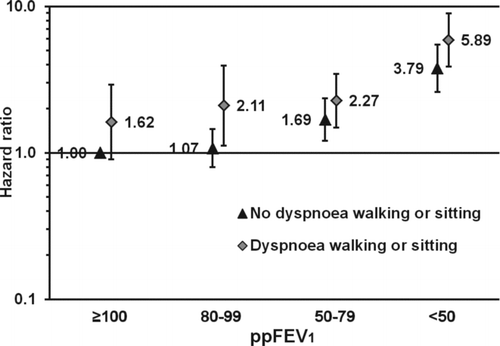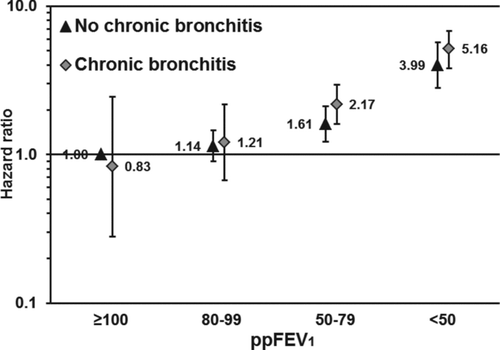Figures & data
Table 1. Statistical models for the association of lung function and respiratory symptoms with all-cause and cardiovascular mortality
Table 2. Baseline characteristics according to lung function and respiratory symptoms among women in the general population (weighteda)
Table 3. Baseline characteristics according to lung function and respiratory symptoms among men in the general population (weighteda)
Table 4. Death rates and adjusted hazard ratios (HRs) with 95% confidence intervals (CIs) for the associations between lung function and all-cause mortality (weighted)
Table 5. Death rates and adjusted hazard ratios (HRs) with 95% confidence intervals (CIs) for the associations between lung function and cardiovascular mortality (weighted) in participants without CVD at baseline
Figure 2. Association of the combined exposure of % predicted forced expiratory volume in 1 second (ppFEV1) and reporting of dyspnoea when walking or sitting with all-cause mortality. The reference category consists of people with ppFEV1 ≥100 not reporting dyspnoea when walking or sitting. The bars represent 95% confidence intervals. Adjusted for age (<40, 40–49, …, ≥80 years), sex (woman, man), smoking (never, former, current, unknown), education (<10, 10–12, ≥13 years, unknown), body mass index (<18.5, 18.5–24.9, 25.0–29.9, ≥30.0 kg/m2), physical activity (inactive, light activity <1 hours/week, light activity 1–2 hours/week, light activity ≥3 hours/week, only vigorous activity, unknown), and cardiovascular disease (yes, no).

Table 6. Death rates and adjusted hazard ratios (HRs) with 95% confidence intervals (CIs) for the associations between respiratory symptoms and all-cause mortality (weighted)
eTable 13. Adjusted hazard ratios (HRs) with 95% confidence intervals (CIs) for the associations of having missing data on the dyspnoea scale with all-cause and cardiovascular mortality (weighted)
Figure 1a. Association of the combined exposure of% predicted forced expiratory volume in 1 second (ppFEV1) and reporting of chronic bronchitis with all-cause mortality. The reference category consists of participants with ppFEV1 ≥ 100 not reporting chronic bronchitis. The bars represent 95% confidence intervals. Adjusted for age (<40, 40–49, . . . , ≥ 80 years), sex (woman, man), smoking (never, former, current, unknown), education (<10, 10–12, ≥13 years, unknown), body mass index (<18.5, 18.5–24.9, 25.0–29.9, ≥ 30.0 kg/m2), physical activity (inactive, light activity <1 hours/week, light activity 1–2 hours/week, light activity ≥3 hours/week, only vigorous activity, unknown), and cardiovascular disease (yes, no).

Figure 1b. Association of the combined exposure of% predicted forced expiratory volume in 1 second (ppFEV1) and reporting of wheeze with all-cause mortality. The reference category consists of participants with ppFEV1≥ 100 not reporting wheeze. The bars represent 95% confidence intervals. Adjusted for age (<40, 40–49, . . . , ≥80 years), sex (woman, man), smoking (never, former, current, unknown), education (<10, 10–12, ≥13 years, unknown), body mass index (<18.5, 18.5–24.9, 25.0–29.9, ≥30.0 kg/m2), physical activity (inactive, light activity <1 hours/week, light activity 1–2 hours/week, light activity ≥ 3 hours/week, only vigorous activity, unknown), and cardiovascular disease (yes, no).


